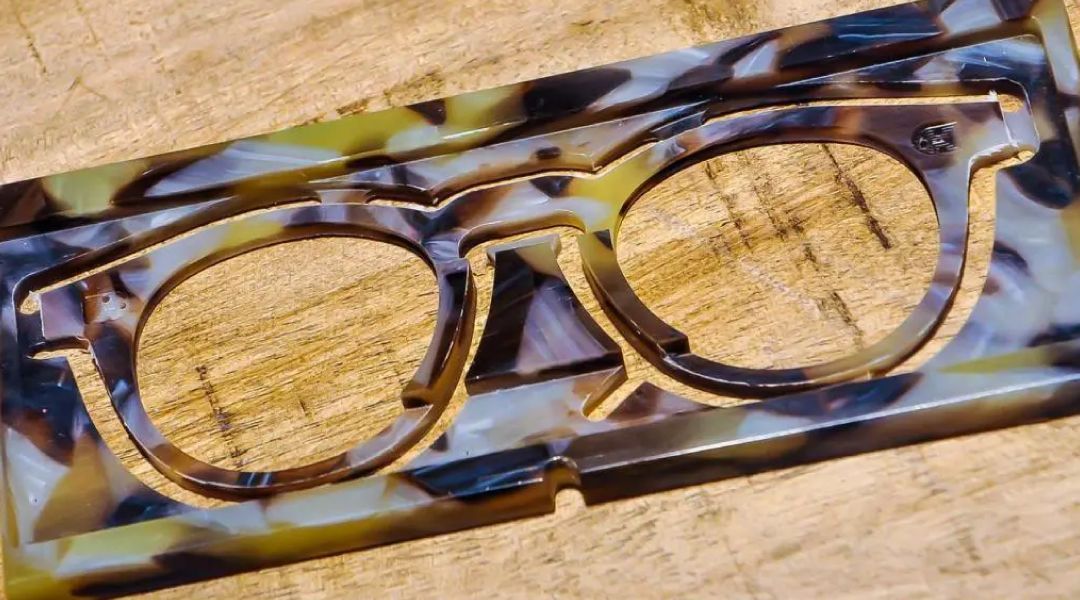Crafting Luxury Eyewear: The Art of Premium Acetate Production

Read time: 4 minutes
In a world dominated by mass production, there's a timeless appeal to the handcrafted and the exclusive. When it comes to high-end luxury eyewear, there's a material that stands out in the crowd: premium acetate. The creation of acetate frames is an art in itself, one that involves a blend of craftsmanship, precision, and an unwavering commitment to quality. In this blog, we will take you on a journey through the meticulous process of producing premium acetate for luxury eyewear.
What is Acetate?
Cellulose acetate is a high-quality, plant-based plastic material renowned for its durability, vibrant colors, and lustrous finish. It is the preferred choice for luxury eyewear due to its flexibility, hypoallergenic properties, and its ability to be shaped into intricate designs.
Step 1: Sourcing the Raw Materials
The journey of creating premium acetate eyewear begins with the careful selection of raw materials. High-end manufacturers choose to use cellulose acetate, sourced from natural cotton and wood fibers. This natural base ensures that the eyewear is not only stylish but also eco-friendly.
The decision to use cellulose acetate isn't just about sustainability; it's also about quality. This premium material offers the perfect balance between strength and flexibility, ensuring that your luxury eyewear lasts for years to come.
Step 2: The Meticulous Blending
Once the raw materials are sourced, the manufacturing process commences with a precise blending of cellulose acetate with plasticizers and stabilizers. This mixture is then carefully heated, creating a thick, malleable material that can be shaped into eyewear frames.
The artistry of creating premium acetate frames lies in crafting this blend to achieve the perfect balance of flexibility and rigidity. This is where the magic begins, as the material begins to take shape and transform into the distinctive eyeglass frames you'll proudly wear.
Step 3: The Color Infusion
Premium acetate is known for its vibrant colors, and achieving these hues requires a meticulous infusion process. Dyes are added to the acetate mixture to create a kaleidoscope of shades. Luxury eyewear brands often experiment with unique color palettes, making each frame a work of art in itself.
The colors in premium acetate eyewear are not just superficial coatings; they run deep within the material, ensuring that your eyeglasses maintain their brilliance over time.
Step 4: Layering and Curing
To achieve the marbled and layered designs that are characteristic of premium acetate frames, the material is carefully layered, creating a visually striking and dynamic pattern. These layered sheets are then cured to enhance the material's strength and durability.
It's this process that gives acetate frames their unique and stunning appearance, making every pair of luxury eyewear a one-of-a-kind masterpiece.
Step 5: Precision Cutting and Shaping
Skilled artisans use precise machinery to cut and shape the acetate sheets into the desired frame design. This step demands exceptional attention to detail and craftsmanship, as every curve and angle must align perfectly. The result is frames that not only look amazing but also fit comfortably and securely.
The precision cutting and shaping phase is a testament to the commitment of luxury eyewear manufacturers to provide you with the best quality possible.
Step 6: Hand Polishing
Hand polishing is an essential step that brings out the lustrous finish of premium acetate frames. Expert craftsmen spend hours meticulously polishing each frame, ensuring a flawless surface and a comfortable fit. This hand-finishing process isn't just about aesthetics; it's about ensuring that your eyeglasses feel as good as they look.
Step 7: Assembly
The final assembly of the eyeglasses involves attaching hinges, temples, and other components. Each pair of luxury eyeglasses is meticulously inspected to ensure that it meets the brand's high standards of quality and aesthetics.
Luxury eyewear brands are committed to perfection. They don't just craft eyeglasses; they create a piece of art that you can wear. This level of attention to detail ensures that when you put on a pair of premium acetate eyeglasses, you're not just making a statement; you're experiencing the epitome of eyewear craftsmanship.
The Takeaway
Premium acetate is not just a material; it's a work of art that adorns the faces of those who appreciate the finer things in life. The creation of luxury eyewear from premium acetate is a testament to the timeless art of craftsmanship, where each pair of glasses is a masterpiece in itself. The next time you put on a pair of premium acetate eyeglasses, remember the dedication and skill that went into crafting those frames, and how they make you feel truly special.
In a world of mass-produced products, premium acetate eyewear stands as a symbol of uniqueness, quality, and a commitment to the finer things in life. So, if you're looking to make a style statement with your eyewear, consider investing in a pair of handcrafted luxury glasses made from premium acetate. Your eyes deserve nothing but the best. It's more than eyewear; it's an experience of art and luxury that you carry with you every day.
Share this blog post on social or with a friend:
The information provided in this article is intended for general knowledge and educational purposes only and should not be construed as medical advice. It is strongly recommended to consult with an eye care professional for personalized recommendations and guidance regarding your individual needs and eye health concerns.
All of Urban Optiks Optometry's blog posts and articles contain information carefully curated from openly sourced materials available in the public domain. We strive to ensure the accuracy and relevance of the information provided. For a comprehensive understanding of our practices and to read our full disclosure statement, please click here.


















